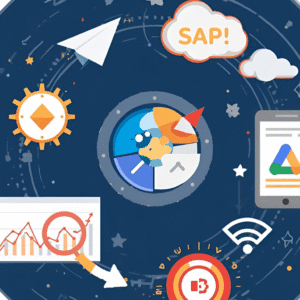In today’s fast-paced digital landscape, relying solely on organic marketing is no longer enough. While search engine optimization (SEO), content marketing, and word-of-mouth remain powerful, they often take time to generate results. If you want to grow faster, build brand awareness, and reach a larger audience, paid advertising is a smart and proven strategy.
From Google Ads to social media advertising platforms like Facebook, Instagram, LinkedIn, and TikTok, businesses have more opportunities than ever to get in front of the right people at the right time. But investing in paid advertising requires more than just running a few random campaigns. To achieve a high return on investment (ROI), you need strategy, planning, and execution.
In this article, we’ll walk through a comprehensive guide on how to invest in paid advertising and expand your reach.
Why Paid Advertising Matters
Paid advertising allows you to amplify your marketing efforts and connect with potential customers who may not find you otherwise. Unlike organic methods, ads can place your message in front of a large, targeted audience almost instantly.
Here are a few key reasons why businesses invest in paid ads:
- Scalability: Ads can quickly scale your business by reaching thousands—or even millions—of potential customers.
- Targeted Reach: Platforms like Google Ads and Facebook Ads allow you to segment your audience by demographics, interests, behaviors, or even intent.
- Speed: Unlike SEO, which can take months, ads can deliver results within hours or days.
- Measurable ROI: Every click, impression, and conversion can be tracked, making it easier to refine your campaigns.
- Competitive Advantage: If your competitors are running ads and you’re not, you may lose potential customers.
Choosing the Right Advertising Platform
Not all advertising platforms are created equal. The right choice depends on your business goals, target audience, and budget. Let’s explore some of the most popular platforms:
1. Google Ads
Google Ads (formerly AdWords) helps you capture people actively searching for your products or services.
- Best for: Businesses targeting high-intent buyers.
- Ad types: Search ads, display ads, shopping ads, and YouTube video ads.
- Strength: Intent-driven—users are already looking for solutions.
2. Facebook Ads
Facebook offers powerful targeting based on demographics, interests, and behaviors.
- Best for: Businesses that want to build brand awareness or drive engagement.
- Ad types: Image ads, video ads, carousel ads, and lead forms.
- Strength: Exceptional audience segmentation and detailed analytics.
3. Instagram Ads
Since Instagram is owned by Meta, ads can be managed through the same platform as Facebook.
- Best for: Brands with strong visuals (fashion, food, travel, lifestyle).
- Ad types: Stories, reels, carousel, and shoppable posts.
- Strength: High engagement among younger demographics.
4. LinkedIn Ads
LinkedIn is a professional network, making it great for B2B advertising.
- Best for: Businesses selling to professionals or enterprises.
- Ad types: Sponsored content, InMail, and lead gen forms.
- Strength: Access to decision-makers and business audiences.
5. TikTok Ads
TikTok has rapidly grown into a leading platform for brands to reach younger audiences.
- Best for: Brands targeting Gen Z and millennials.
- Ad types: In-feed ads, branded content, and hashtag challenges.
- Strength: Viral potential and creative storytelling opportunities.
Setting Clear Goals and Budgets
Before spending a single dollar on ads, define your goals. Paid advertising can achieve different objectives:
- Brand awareness: Increase visibility and recognition.
- Lead generation: Collect emails, phone numbers, or inquiries.
- Sales: Drive direct conversions on your website or e-commerce store.
- Engagement: Encourage likes, comments, and shares.
- Traffic: Increase visitors to your website or blog.
Budgeting for Ads
There is no one-size-fits-all budget. The right budget depends on your industry, competition, and goals. A few guidelines:
- Start small: Test campaigns with smaller budgets before scaling.
- Use cost-per-click (CPC) benchmarks: On Google, CPC varies by industry (e.g., legal and finance are expensive, while e-commerce is cheaper).
- Allocate per goal: If sales are your main target, focus more on conversion-driven campaigns.
Pro tip: Always reserve at least 20% of your budget for testing new strategies.
Crafting Compelling Ad Creatives
Your ads need to grab attention, build trust, and encourage clicks.
Elements of a High-Converting Ad:
- Strong Headline: Your headline should be clear, engaging, and value-driven.
- Visuals: Use high-quality images or videos to capture attention.
- Value Proposition: Clearly explain what makes your offer unique.
- Call-to-Action (CTA): Phrases like “Sign up now,” “Shop today,” or “Get started” work best.
- Consistency: Ensure your ad messaging aligns with your landing page.
Examples:
- For a fitness app: “Get Fit at Home – Try Our Free 7-Day Trial Today.”
- For a fashion brand: “Summer Collection 2025 – 20% Off This Week Only.”
Targeting the Right Audience
Targeting is the backbone of paid advertising. Without it, you risk wasting money on clicks that don’t convert.
Key Targeting Methods:
- Demographics: Age, gender, location, income level.
- Interests & Behaviors: Hobbies, lifestyle choices, and purchase behavior.
- Custom Audiences: Upload your email list or retarget past visitors.
- Lookalike Audiences: Platforms like Facebook allow you to target people similar to your existing customers.
- Keywords: On Google Ads, targeting keywords ensures your ad shows up when users search relevant terms.
Pro tip: Retargeting campaigns usually deliver the highest ROI, as they focus on users already familiar with your brand.
Measuring and Optimizing Campaigns
Launching your ads is only the beginning. The real work lies in tracking performance and optimizing for better results.
Key Metrics to Track:
- Click-through rate (CTR): Percentage of people who click your ad.
- Conversion rate: Percentage of users completing your desired action.
- Cost per click (CPC): How much you pay for each click.
- Cost per acquisition (CPA): Cost to acquire a customer.
- Return on ad spend (ROAS): Revenue generated compared to ad spend.
Optimization Techniques:
- A/B Testing: Test different headlines, visuals, and CTAs.
- Adjust Targeting: Narrow or expand audiences based on performance.
- Bid Strategy: Switch between automated and manual bidding depending on results.
- Ad Scheduling: Run ads during peak engagement hours.
- Landing Page Optimization: Improve website speed, design, and messaging.
Best Practices for Long-Term Success
Paid advertising should not be treated as a one-time experiment but as a long-term growth strategy.
- Start with Clear Data: Install tracking tools like Google Analytics, Facebook Pixel, and UTM tags.
- Keep Testing: The best advertisers constantly test new creatives, copy, and targeting.
- Combine Paid and Organic Marketing: Use ads to amplify high-performing content and drive faster growth.
- Avoid Ad Fatigue: Refresh creatives every few weeks to maintain engagement.
- Focus on Customer Experience: Even the best ads won’t work if your product, service, or website disappoints customers.
Final Thoughts
Investing in paid advertising is one of the fastest ways to expand your reach, grow your audience, and increase revenue. Whether you’re running Google Ads to capture search traffic or social media ads to build awareness, success depends on strategic planning, creativity, and continuous optimization.
Start by choosing the right platform, setting clear goals, and testing different approaches. Over time, you’ll gather valuable insights about your audience, refine your strategy, and maximize ROI.
Remember, paid advertising is not an expense—it’s an investment in growth.







